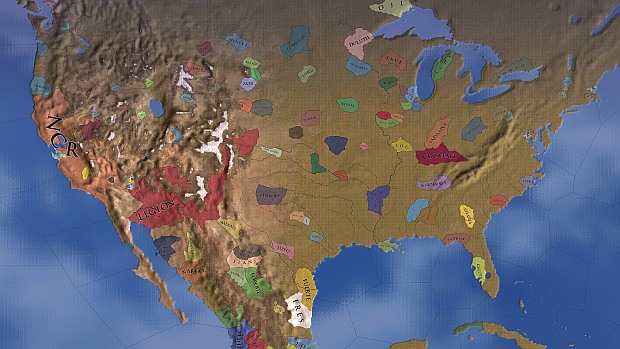

The Crusades, which started late in the 11th century, bred the religious ideology of a Christian reconquest, confronted at that time with a similarly staunch Muslim Jihad ideology in Al-Andalus by the Almoravids, and to an even greater degree by the Almohads. The Islamic Almohad dynasty and surrounding states, including the Christian Kingdoms of Portugal, Leon, Castile, Navarre, and the Crown of Aragon, c. However, this idea has been challenged by scholars today. The period is seen today to have had long episodes of relative religious tolerance. Blurring distinctions even further were the mercenaries from both sides who simply fought for whoever paid the most. Alliances between Muslims and Christians were not uncommon. Both Christian and Muslim rulers fought amongst themselves. A landmark was set by the Christian Chronica Prophetica (883–884), a document stressing the Christian and Muslim cultural and religious divide in Hispania and the necessity to drive out the Muslims, considered as a restoration of the Visigothic Kingdom in the conquered territories. The concept of a Christian reconquest of the peninsula first emerged at the end of the 9th century. Since the 19th century, traditional historiography has stressed the existence of the Reconquista, a continuous phenomenon by which the Christian Iberian kingdoms opposed and conquered the Muslim kingdoms, understood as a common enemy who had militarily seized territory from native Iberian Christians.

Likewise, on 30 July 1492, all the Jewish community – some 200,000 people – were forcibly expelled.īeginning in the 19th century, traditional historiography has used the term Reconquista for what was earlier thought of as a restoration of the Visigothic Kingdom over conquered territories.
#CK2 EXTENDED TIMELINE MOD SERIES#
The conquest was followed by a series of edicts (1499–1526) which forced the conversions of Muslims in Spain, who were later expelled from the Iberian peninsula by the decrees of King Philip III in 1609. After 1492, the entire peninsula was controlled by Christian rulers. The northern kingdoms took advantage of this situation and struck deep into al-Andalus they fostered civil war, intimidated the weakened taifas, and made them pay large tributes ( parias) for "protection".Īfter a Muslim resurgence in the 12th century, the great Moorish strongholds in the south fell to Christian forces in the 13th century after the decisive battle of Navas de Tolosa (1212)- Córdoba in 1236 and Seville in 1248-leaving only the Muslim enclave of Granada as a tributary state in the south.

When the government of Córdoba disintegrated in the early 11th century, a series of petty successor states known as taifas emerged. His armies ravaged the north, even sacking the great Santiago de Compostela Cathedral. In the late 10th century, the Umayyad vizier Almanzor waged military campaigns for 30 years to subjugate the northern Christian kingdoms. The rebels who were led by Pelagius defeated a Muslim army in the mountains of northern Hispania and established the independent Christian Kingdom of Asturias. The beginning of the Reconquista is traditionally marked with the Battle of Covadonga (718 or 722), the first known victory by Christian military forces in Hispania since the 711 military invasion which was undertaken by combined Arab- Berber forces. The Reconquista ( Portuguese and Spanish for "reconquest") was a period in the history of the Iberian Peninsula of about 781 years of war between the Umayyad conquest of Hispania in 711, the expansion of the Christian kingdoms throughout Hispania, and the fall of the Nasrid kingdom of Granada in 1492. Depiction of battle, taken from the Cantigas de Santa Maria


 0 kommentar(er)
0 kommentar(er)
